Selection harvesting of radiata pine
John Wardle, New Zealand Tree Grower November 2019.
Judging by the number of articles which have appeared in the February and May issues of the Tree Grower, there is obviously a certain amount of interest in selective harvesting of radiata pine using target diameter criteria. We have been using this system for the harvest of our radiata pine plantations since 2002 and some of our stands have now received nine harvest visits over 18 years. We are at the stage where we are well into the high pruning phase for regenerating pine while there is still a resource of the original planted stands awaiting later harvest.
There is a detailed account of our management of pine at Woodside in the NZ Journal of Forestry Vol 63 No 4, and there also an account on YouTube under Woodside Case Study. This article is designed to give a summary of some of our experiences using selective harvesting, particularly explaining why we opted for the system in the first place, what we have learned relating to its application, where it could perhaps be appropriately used by others and what are its limitations.
One of the main reasons we initially opted to harvest our radiata pine using the system was that our stands were planted on hill country with large site variation over short distances, resulting in variable growth rates, with some trees growing at double the rate of their neighbours. Consequently, clear felling on a set-age basis would have resulted in many trees having to be harvested before they reached their economic optimum while others would have become over-sized. This loss of potential individual tree value was particularly significant in that all selected final crop trees had been high pruned and the returns from harvesting is therefore strongly linked to the amount of clear wood produced outside of the central knotty core zone.
A summary of what we have learned over the 18 years over which we have applied the selection harvesting option follows.
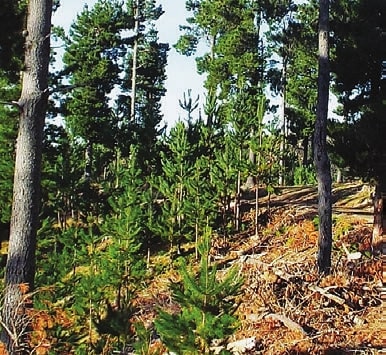
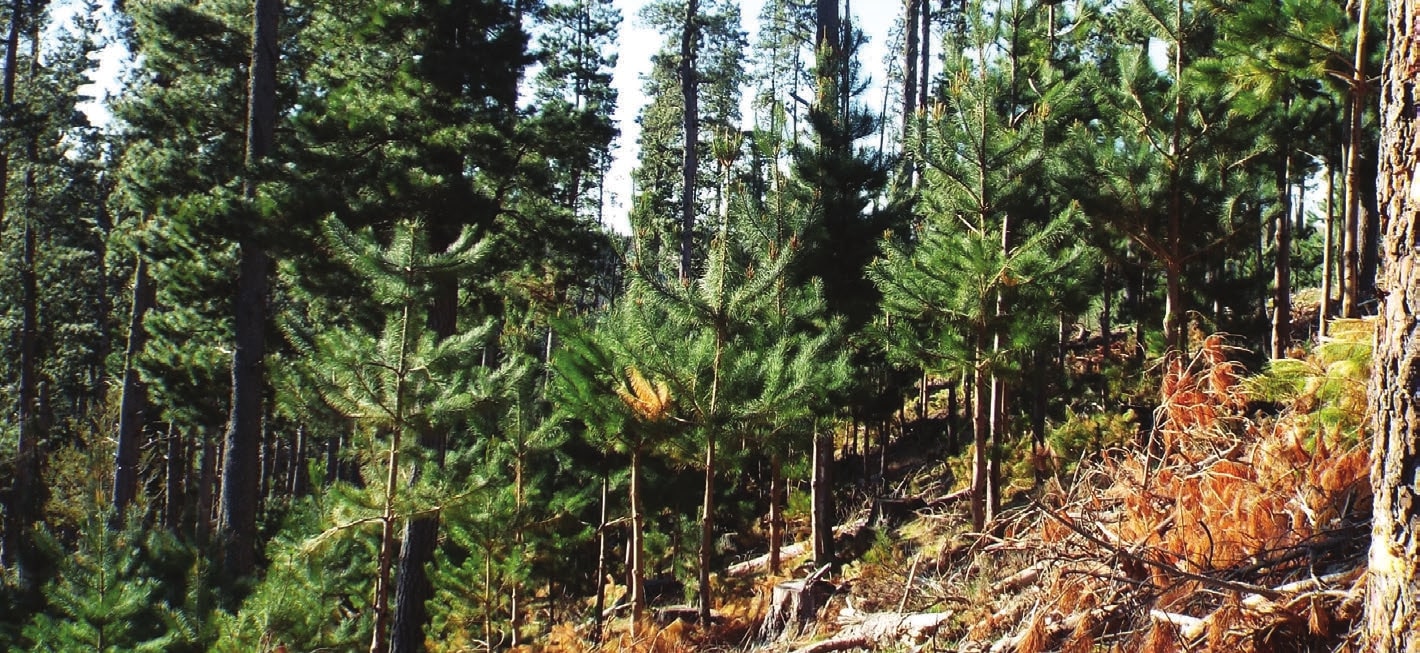
Effect of site
The system that we have used would be difficult to apply in an homogenous site where trees in a stand are growing at more-or-less the same rate because the majority of stems would approach the selected target diameter over a relatively narrow time range. This contrasts with our site where, over the last 18 years, between 10 and 16 trees per hectare consistently grow into the target diameter class of 60 cm annually.
Plantation size
Even where there is significant variation in site and growth rates, plantation size has to be large enough to warrant a number of visits by harvesting crews, taking only a proportion of the total stand volume at each visit. At Woodside we have opted for repeat harvests every two years.
Our reasoning has been that if we carry out annual harvests then the volume of timber being extracted at each visit would have a strong negative effect on the economic viability of the operation. On the other hand, longer intervals between harvests, although increasing the wood volumes being extracted at each visit, would decrease the stability of the stand, making trees more susceptible to wind damage.
For us, the operation is economically viable because we have sufficient plantation area to support an annual harvest of 800 to 1000 cubic metres. We are harvesting 40 cubic metres a hectare annually which translated to 80 cubic metres a hectare at each visit. The nett returns, after harvesting and other costs have been subtracted, amount to about $50 a cubic metre.
For any harvesting operation, clear felling or otherwise, there is an economy of scale. Factors such as positioning of machinery and having sufficient log volumes to capitalise on the most remunerative combinations of grades, come into play. Smaller plantations are at a disadvantage and this is particularly so using systems such as selection felling where only a portion, usually less than 10 per cent, of the crop is removed at any one visit.
Financial returns
Our harvesting costs are larger than if we had clear felled, but not substantially so as the average size of the trees being harvested is greater. In our case, the average merchantable volume extracted from each harvested tree is about 3.1 tonnes. The higher harvesting costs translate to lower financial returns.
This may well change in the future as the ingrowth from natural regeneration ultimately converts the stands to a ‘normal’ balanced mixed aged structure. Once this state is reached, the average annual merchantable wood volumes available for harvest should ultimately increase as stocking rates per unit area can be higher. They are not then controlled to the same extent by competition at the end of the rotation from final crop trees as they are in fully stocked even-aged stands.
Selection harvesting allows for a sustained annual income stream, whereas clear felling provides lump sum returns at intervals equivalent to rotation length, and this had a strong influence on our decision to opt for the selection option. This choice, however, depends very much on the aspirations of the forest owner.
Timber quality
The average age of trees being harvested is older than for the clear felling option and this has a positive influence on wood stiffness. On the other hand, timber quality can be adversely affected by extraction related damage to the bark of trees retained for future harvest.
Our stands, as is typically the case in the Canterbury foothills, are subjected to strong and often gale force north-west winds and this has resulted in a high incidence of off-centre pith. As a result only a small proportion of our pruned butt logs qualify for the most remunerative veneer market, and are therefore sold as saw logs. There are indications that the regenerating stands have sufficient protection afforded by the canopy of the older trees to overcome this problem and will ultimately qualify for the more remunerative market.
Natural regeneration
Natural regeneration occurs in adequate densities over about 90 per cent of the areas which we have subjected to selection harvesting. This means that there have not been the same costs associated with seedling purchase and planting that there would have been with more orthodox management options. On the other hand, seedling densities in some areas can be high, although not excessively so, and this allows for improved selection for form and growth rate. It usually also means that an extra thinning operation is required.
However, if this is done at an early stage using scrub cutters, the cost of the operation is relatively cheap. At any rate, it is prudent to retain stem densities throughout the pruning and thinning silvicultural cycle which are 25 to 30 per cent greater than what would be regarded as adequate using more typical regimes for radiata pine. This is to compensate for potential damage to the regenerating crop from the repeated harvesting operations, and also to allow for seedlings being bent over by heavy snow and antler rubbed by deer. We lose a considerable number of saplings from these causes in most years.
Our regenerating stands are now at the stage that we are undertaking the full range of pruning and thinning operations, with a significant number of stems now having been pruned to six metres in height. It seems to us that the growth rates up to this stage are at least as good as they are for plantings which have been carried out in open ground, while form is actually improved. This probably results from the shelter provided by the remnant parent canopy from the original plantings. Branch size is generally smaller and this to a degree compensates for the cost of having to prune extra stems to allow for logging damage.
A major problem which we have encountered relates to weed control. Many of our stands were planted in areas which were originally covered in gorse. The light requirements for pine to regenerate are similar to that required for seeds of gorse in the soil to germinate. Consequently, as the canopy of the parent stand is opened up by repeated harvests, gorse becomes a problem. Blackberry, ferns and wineberry are all more shade tolerant than pine. These inhibit pine regeneration on the lower moister slopes and gully sites.
Therefore, a programme of weed control is necessary to encourage pine regeneration and this is undertaken using a combination of scrub-cutting, spraying and sheep grazing. Aerial spraying cannot be undertaken because of potential damage to the existing canopy so we have had to resort to the use of knapsacks. To control gorse, spraying has to be carried out twice each year and this is an expensive operation. In moister gully sites we are opting to enrich the radiata stands with more shade tolerant species such as coastal redwood and hybrid cypresses.
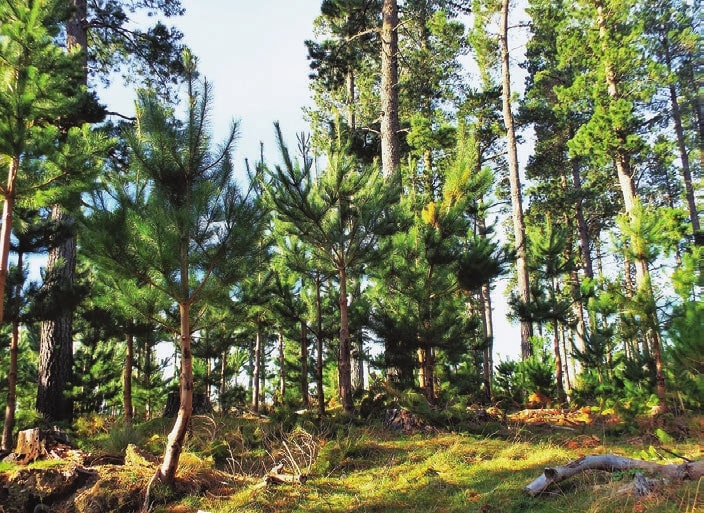
Logging damage
There is potential for significant damage to the standing trees, to regenerating pine and to the soil when selective harvesting options are used. The extent of damage depends on a number of factors including −
- The expertise of the logging crew
- Weather and soil conditions at time of harvest
- The type of logging equipment used
- The extent to which a stand has been opened up by previous harvest visits.
As might be expected, the greatest potential for damage to standing trees, regardless of the type of logging equipment used, is when stand densities are highest during early harvest visits. The potential for damage falls as the stand becomes opened up by repeated visits as there is more room between trees for the movement of machinery. In addition, the space between trees allows for more options for directional felling. However, natural regeneration of pine increases as the canopy becomes more open, and avoiding damage to these young trees becomes progressively more difficult.
We have tried a number of harvesting options since we began selectively harvesting our pine, including manual felling using chainsaws, felling and trimming using harvesters equipped with felling heads, rubber tyred skidders with winch ropes for hauling felled trees and tracked diggers for shovelling and loading trucks.
For us, the least damage to both the soil and standing trees has been with the combination of directional felling by men on the ground using chainsaws, and log haulage by rubber tyred skidders equipped with winch ropes. The worst option has been using tracked harvesters equipped with felling heads. Tracked machinery causes much more soil disturbance especially under wet conditions and this is exacerbated by the use of felling heads which need the machines being used to be close to the trees being felled. This necessitates more machinery movement within the stands and therefore a greater potential for soil damage and damage to standing trees.
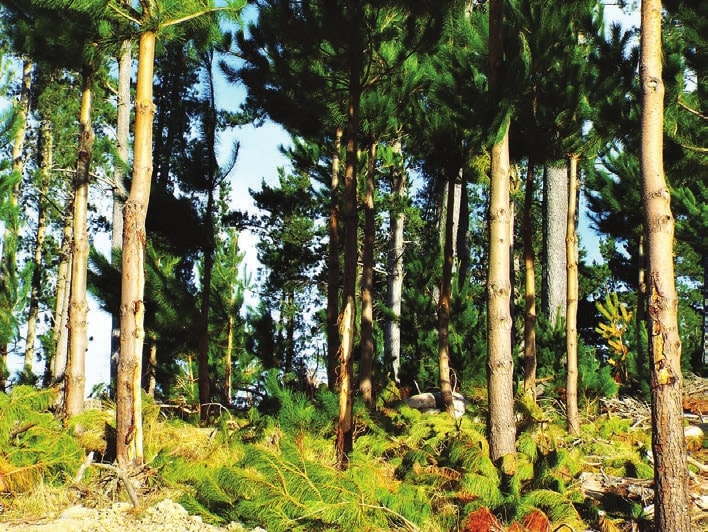
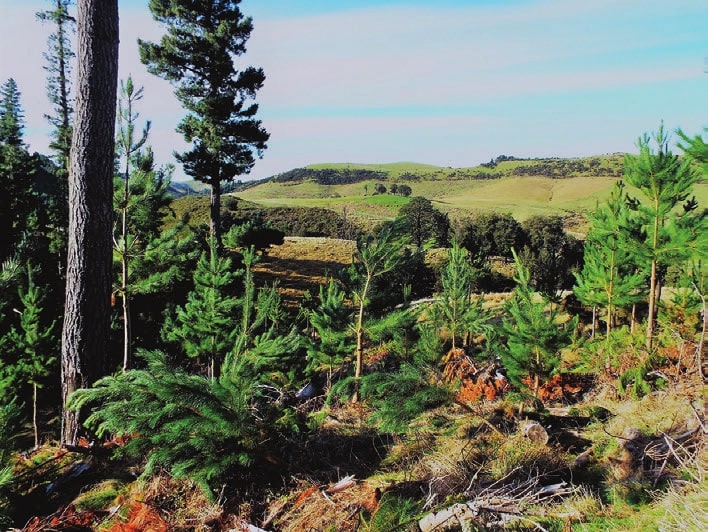
Roading
Damage to standing trees and forest soils are considerably reduced when the movement of logging machinery, and log haulage within stands which are being selectively harvested, is kept to a minimum. The extent of damage is therefore influenced by the intensity of the network of roading and formed tracks within the forest. The ideal is where the network is intensive enough that logging machinery does not have to operate from within the stands but can be restricted to these roads and tracks. However, it is unlikely that this ideal can generally be achieved.
At Woodside, the 2013 gales which destroyed many plantations in the Canterbury region seemed to us at the time to be a disaster. We had about 1,500 tonnes of trees flattened which was greater than our normal annual harvest. However, we were able to salvage about 1,000 tonnes.
In retrospect the storm proved to be beneficial as we were forced to establish an intensive network of tracks to harvest the main areas of windthrow. These tracks are now part of our permanent roading system and they give us good access for repeated selective harvesting of most of our stands. We can now access over 90 per cent of our forest without the harvesting machinery having to move off our formed tracks. Similar access to stands for selection logging could be provided where there is a mosaic of plantations located within a predominantly pastoral landscape.
Stability to wind
One of our main concerns when we opted for selection harvesting was that we would be subjecting our stands to an increased risk of toppling by wind. It was for this reason that we opted for frequent cuts, in our case at two-year intervals, and the removal of a relatively small proportion of the trees at any one visit.
What we have found is that the residual stand appears to be more stable than even-aged forest, and the reason seems to be two-fold. Root extension on retained trees is rapid and this gives greater stability, and the partial removal of the canopy allows for freer air movement during strong winds.
Environmental considerations
Selection harvesting provides numerous environmental and aesthetic benefits when compared with clear felling. The forest assumes a multi-tiered structure which has benefits for forest plants and animals, and conditions within the forest remain relatively stable rather than undergoing massive changes every 30 to 40 years.
There are not the large accumulations of logging debris or the risk of soil erosion which are so much a feature of steep land felling operations. Finally, the visual impact of selective systems is much less obtrusive than with equivalent clear felling operations.
To summarise
Selective harvesting of our pine has proved to be an attractive alternative to clear felling. It provides us with a relatively regular annual income rather than a lump sum at the end of a rotation and it is environmentally and visually a better option. However, as I have attempted to indicate, it has a number of limitations and is certainly not an option for a lot of forest owners.

 Farm Forestry New Zealand
Farm Forestry New Zealand